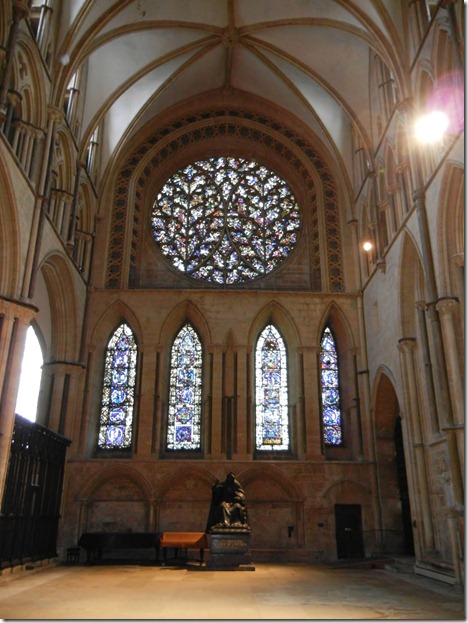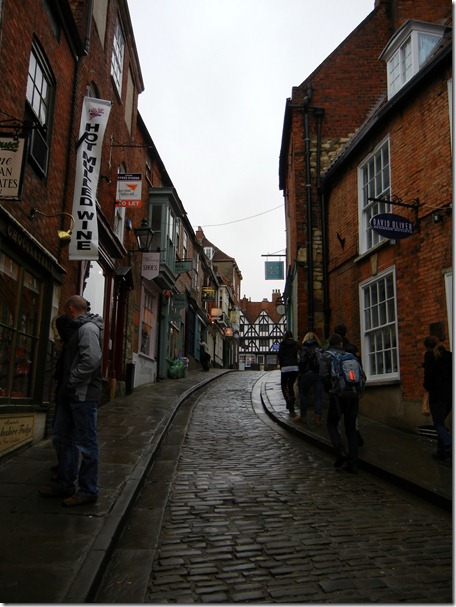Rainy Day In Lincoln
Posted: February 3, 2011 | Author: kirchgrj | Filed under: Lincoln, Travel | Tags: abroad, Castle, Cathedral, England, Harlaxton, Harlaxton College, Lincoln, Lincoln Castle, Lincoln Cathedral, photography, rainy day, studying abroad, tourism, UK | 1 CommentOn January 26, I went on a field trip to the town of Lincoln for my British Studies course at Harlaxton College. The whole school was required to attend the trip. Students were divided into three groups: A, B, C, and D.The four groups took turns rotating around scheduled tours in Lincoln.
I was assigned to group B and our first tour was to be ‘self-guided’. The school gave us the liberty to take the time to walk around Lincoln and see the town for ourselves with a few suggested stops. The weather was quite awful for walking around because it was about 34°F and raining. I proceeded to self-guide myself to a café where I could comfortably sit in the warmth of a building while sipping on a hot chocolate.
This is Steep Hill street leading to Castle Square. The name is very fitting because the street is in fact on a very steep hill. The café was just down the street from here and where other locals also took refuge from the uninviting English weather.
After an hour of just relaxing, it was time to get up and meet in Castle Square for my first guided tour, which was of Lincoln Castle. The site where Lincoln Castle now stands was originally a legionary fortress by the Roman Empire in the first century. It wasn’t until 1068 AD that the construction of the castle began by William the Conqueror two years after he was victorious at the Battle of Hastings.
View of Lincoln Castle’s 13th century east gate and observatory from Castle Square.
Lincoln Castle is placed on a strategic location because it sits atop the highest hill in Lincoln and controls the crossing over the Whitham River. The Norman’s built castles such as this, as way of enforcing their control of the population after conquering England.
This is from within the castle’s walls at the base of the observatory looking out onto Lincoln. If it wasn’t raining, the view of the town would be more impressive.
One of the main attractions of Lincoln Castle is an original copy of the Magna Carta, the very place where King John placed his seal on in 1212. It is one of the only four original copies still left today. Monks wrote up to what is believed between 60 to 70 copies of the Magna Carta in short hand Latin. Only one of the copies bears the seal of King John.
My guided tour of the castle was only for an hour, which was great because I was tired of being in the cold rain. I ate my packed lunch in the castle’s café where it was warm and dry.
My next tour was of the very impressive Lincoln Cathedral.
This picture was taken from one of the towers in Lincoln Castle. The cathedral dominates the landscape and towers over all the other buildings.
For a brief moment the rain stopped and sun began to shine and illuminated Lincoln Cathedral. Was this a sign of the things to come?
Lincoln Cathedral began construction in 1072 by the Normans. The original architecture of the cathedral was Romanesque, but in 1185 it was severely damaged by an earthquake. Lincoln Cathedral had to be mostly rebuilt, this time in the more contemporary Gothic style. Only the west front as seen from Castle Square is original.
The magnitude of Lincoln Cathedral is hard to grasp at first. The spires that penetrate the skyline are in fact taller than the Great Pyramids in Egypt. The scale of this building is phenomenal and is a perfect personification of how powerful the monarch, the church, and God were.
The Nave of Lincoln Cathedral is absolutely breathtaking. The columns and arches to the sides provide support to the magnificent ribbed vaulting.
The cathedral was built in the shape of a cross to represent the same cross in which Jesus died on. The cathedral is also decorated with elegant stained glass allowing as much sunlight in as possible, symbolizing the presence and power of God. 
Off the Nave is the Crossing with the North and South Transept coming off to either side. This is a frame of the South Transept, also known as the Bishop’s Eye. To give a sense of scale, the statue of St. Hugh is about 7 feet tall.
My tour of Lincoln Cathedral only lasted about an hour and then it was time to go on my last and final tour, ‘The Roman Walk’. Which meant being out of the dry cathedral and back into the cold and wet town. The Roman walk was a walk around the center of Lincoln looking at ancient Roman sites including a well, an aqueduct, the forum, and Newport Arch . There is not much of these to be seen anymore because most of it is now underground.
Newport Arch is one of the last Roman structures today still standing in Lincoln. To my surprise, people are still allowed to drive under it. The sun shined again for all of one minute and then the rain was back.
A strip of homes overlooking green space by Lincoln Cathedral that I came across on the Roman walk.
The Roman walk thankfully lasted a little less than an hour. I was very happy to get out of the cold rain and onto the coach back to the manor. Lincoln was a great town to see and it is rich with history. How many towns can say that they have ancient Roman sites, 13th century castle walls, and a cathedral that is on the same scale as the Great Pyramids? No other towns come to my mind.
A rainy day in Lincoln was miserable at times, but if given the opportunity I would do it all over again. With a slightly warmer jacket of course.













